Detection of Wet Snow by Weakly Supervised Deep Learning Change Detection Algorithm with Sentinel-1 Data
Abstract
1. Introduction
2. Study Area and Data Sources
2.1. Study Area
2.2. Data Sources
2.2.1. Sentinel-1 Data
2.2.2. Landsat 8 OLI Data
2.2.3. Other Auxiliary Data
3. Methodology
3.1. Acquisition of Differential Image
3.2. Weakly Supervised Dual-Branch Deep Learning Change Detection Algorithm
3.2.1. Hierarchical Fuzzy C-Means
3.2.2. Dual-Branch Deep Learning Model
3.3. Other Methods
3.4. Accuracy Evaluation Metrics
4. Results
4.1. Comparison of Wet Snow Detection Accuracy Validation Results
4.2. Wet Snow Cover Percentage across Various Elevation Zones
4.3. Temporal Characteristics of Wet Snow
5. Discussion
5.1. Differences in Wet Snow Detection Results with Different Data Combinations
5.2. Under Cloud Wet Snow Detection
5.3. Uncertainties
6. Conclusions
- (1)
- This study proposes a dual-branch deep learning model that incorporates a Multi-region Convolution module and ResNet18 for wet snow detection. This model operates within a weakly supervised classification framework and is distinguished by its capacity to autonomously learn complex features of wet snow, effectively utilize spatial neighborhood information, and reduce reliance on manual intervention. It can perform effective extraction in the absence of a large amount of labeled data.
- (2)
- The experiments showed that combinations of differential images, VV polarization data, and slope information provide advantages in wet snow extraction. Precision verification with optical imagery revealed that the average overall accuracy of wet snow detection in the study area was 85.2%. The overall accuracy of our method is particularly high when the proportion of wet snow cover is substantial.
Author Contributions
Funding
Data Availability Statement
Acknowledgments
Conflicts of Interest
References
- Hammond, J.C.; Saavedra, F.A.; Kampf, S.K. Global snow zone maps and trends in snow persistence 2001–2016. Int. J. Climatol. 2018, 38, 4369–4383. [Google Scholar] [CrossRef]
- Liu, Z.; Cuo, L.; Sun, N. Tracking snowmelt during hydrological surface processes using a distributed hydrological model in a mesoscale basin on the Tibetan Plateau. J. Hydrol. 2023, 616, 128796. [Google Scholar] [CrossRef]
- Mankin, J.S.; Viviroli, D.; Singh, D.; Hoekstra, A.Y.; Diffenbaugh, N.S. The potential for snow to supply human water demand in the present and future. Environ. Res. Lett. 2015, 10, 114016. [Google Scholar] [CrossRef]
- Che, T.; Hao, X.; Dai, L.; Li, H.; Huang, X.; Xiao, L. Snow Cover Variation and Its Impacts over the Qinghai-Tibet Plateau. Bull. Chin. Acad. Sci. 2019, 34, 1247–1253. [Google Scholar]
- Jain, S.K.; Goswami, A.; Saraf, A.K. Snowmelt runoff modelling in a Himalayan basin with the aid of satellite data. Int. J. Remote Sens. 2010, 31, 6603–6618. [Google Scholar] [CrossRef]
- Nagler, T.; Rott, H. Retrieval of wet snow by means of multitemporal SAR data. IEEE Trans. Geosci. Remote Sens. 2000, 38, 754–765. [Google Scholar] [CrossRef]
- Dong, C. Remote sensing, hydrological modeling and in situ observations in snow cover research: A review. J. Hydrol. 2018, 561, 573–583. [Google Scholar] [CrossRef]
- Dietz, A.J.; Kuenzer, C.; Gessner, U.; Dech, S. Remote sensing of snow–a review of available methods. Int. J. Remote Sens. 2012, 33, 4094–4134. [Google Scholar] [CrossRef]
- Awasthi, S.; Varade, D. Recent advances in the remote sensing of alpine snow: A review. GIScience Remote Sens. 2021, 58, 852–888. [Google Scholar] [CrossRef]
- Hao, X.; Huang, G.; Zheng, Z.; Sun, X.; Ji, W.; Zhao, H.; Wang, J.; Li, H.; Wang, X. Development and validation of a new MODIS snow-cover-extent product over China. Hydrol. Earth Syst. Sci. 2022, 26, 1937–1952. [Google Scholar] [CrossRef]
- Hao, X.; Huang, G.; Che, T.; Ji, W.; Sun, X.; Zhao, Q.; Zhao, H.; Wang, J.; Li, H.; Yang, Q. The NIEER AVHRR snow cover extent product over China–a long-term daily snow record for regional climate research. Earth Syst. Sci. Data 2021, 13, 4711–4726. [Google Scholar] [CrossRef]
- Riggs, G.A.; Hall, D.K. Reduction of cloud obscuration in the MODIS snow data product. In Proceedings of the 59th Eastern Snow Conference, Stowe, VT, USA, 5–7 June 2002; Volume 5. [Google Scholar]
- Wang, X.; Han, C.; Ouyang, Z.; Chen, S.; Guo, H.; Wang, J.; Hao, X. Cloud–Snow Confusion with MODIS Snow Products in Boreal Forest Regions. Remote Sens. 2022, 14, 1372. [Google Scholar] [CrossRef]
- Xiao, P.; Feng, X.; Xie, S.; Du, J. Research progresses of high-resolution remote sensing of snow in Manasi River Basin in Tianshan Mountains, Xinjiang Province. J. Nanjing Univ. (Nat. Sci.) 2015, 51, 909–920. [Google Scholar]
- Darychuk, S.E.; Shea, J.M.; Menounos, B.; Chesnokova, A.; Jost, G.; Weber, F. Snowmelt characterization from optical and synthetic-aperture radar observations in the La Joie Basin, British Columbia. Cryosphere 2023, 17, 1457–1473. [Google Scholar] [CrossRef]
- Tsai, Y.L.S.; Dietz, A.; Oppelt, N.; Kuenzer, C. Remote sensing of snow cover using spaceborne SAR: A review. Remote Sens. 2019, 11, 1456. [Google Scholar] [CrossRef]
- Marin, C.; Bertoldi, G.; Premier, V.; Callegari, M.; Brida, C.; Hürkamp, K.; Tschiersch, J.; Zebisch, M.; Notarnicola, C. Use of Sentinel-1 radar observations to evaluate snowmelt dynamics in alpine regions. Cryosphere 2020, 14, 935–956. [Google Scholar] [CrossRef]
- Nagler, T.; Rott, H.; Ripper, E.; Bippus, G.; Hetzenecker, M. Advancements for snowmelt monitoring by means of Sentinel-1 SAR. Remote Sens. 2016, 8, 348. [Google Scholar] [CrossRef]
- Karbou, F.; Veyssière, G.; Coleou, C.; Dufour, A.; Gouttevin, I.; Durand, P.; Gascoin, S.; Grizonnet, M. Monitoring wet snow over an alpine region using Sentinel-1 observations. Remote Sens. 2021, 13, 381. [Google Scholar] [CrossRef]
- Torralbo, P.; Pimentel, R.; Polo, M.J.; Notarnicola, C. Characterizing snow dynamics in semi-arid mountain regions with multitemporal Sentinel-1 imagery: A case study in the Sierra Nevada, Spain. Remote Sens. 2023, 15, 5365. [Google Scholar] [CrossRef]
- Liu, C.; Li, Z.; Zhang, P.; Wu, Z. Seasonal snow cover classification based on SAR imagery and topographic data. Remote Sens. Lett. 2022, 13, 269–278. [Google Scholar] [CrossRef]
- Gallet, M.; Atto, A.; Karbou, F.; Trouvé, E. Wet snow detection from satellite SAR images by machine learning with physical snowpack model labelling. IEEE J. Sel. Top. Appl. Earth Obs. Remote Sens. 2023, 17, 2901–2917. [Google Scholar] [CrossRef]
- Qu, X.; Gao, F.; Dong, J.; Du, Q.; Li, H. Change detection in synthetic aperture radar images using a dual-domain network. IEEE Geosci. Remote Sens. Lett. 2021, 19, 4013405. [Google Scholar] [CrossRef]
- Shafique, A.; Cao, G.; Khan, Z.; Asad, M.; Aslam, M. Deep learning-based change detection in remote sensing images: A review. Remote Sens. 2022, 14, 871. [Google Scholar] [CrossRef]
- Du, Y.; Zhong, R.; Li, Q.; Zhang, F. TransUNet++ SAR: Change detection with deep learning about architectural ensemble in SAR images. Remote Sens. 2022, 15, 6. [Google Scholar] [CrossRef]
- Wang, Y.; Su, J.; Zhai, X.; Meng, F.; Liu, C. Snow coverage mapping by learning from Sentinel-2 satellite multispectral images via machine learning algorithms. Remote Sens. 2022, 14, 782. [Google Scholar] [CrossRef]
- Wang, Z.; Fan, B.; Tu, Z.; Li, H.; Chen, D. Cloud and snow identification based on DeepLab v3+ and CRF combined model for GF-1 WFV images. Remote Sens. 2022, 14, 4880. [Google Scholar] [CrossRef]
- Yang, J.; Li, W.; Chen, K.; Liu, Z.; Shi, Z.; Zou, Z. Weakly supervised adversarial training for remote sensing image cloud and snow detection. IEEE J. Sel. Top. Appl. Earth Obs. Remote Sens. 2024, 17, 15206–15221. [Google Scholar] [CrossRef]
- Zhang, W.; Shen, Y.; Wang, N.; He, J.; Chen, A.; Zhou, J. Investigations on physical properties and ablation processes of snow cover during the spring snowmelt period in the headwater region of the Irtysh River, Chinese Altai Mountains. Environ. Earth Sci. 2016, 75, 199. [Google Scholar] [CrossRef]
- Zhang, W.; Shen, Y.; He, J.; He, B.; Wu, X.; Chen, A.; Li, H. Assessment of the effects of forest on snow ablation in the headwaters of the Irtysh River, Xinjiang. J. Glaciol. Geocryol. 2014, 36, 1260–1270. [Google Scholar]
- Wu, X.; Zhang, W.; Li, H.; Long, Y.; Pan, X.; Shen, Y. Analysis of seasonal snowmelt contribution using a distributed energy balance model for a river basin in the Altai Mountains of northwestern China. Hydrol. Process. 2021, 35, e14046. [Google Scholar] [CrossRef]
- Wu, X.; Pan, X.; Shen, Y.; Zhang, W.; He, J.; He, B. Validation of WRF model on simulating forcing data for Kayiertesi River basin, Xinjiang. J. Glaciol. Geocryol. 2016, 38, 332–340. [Google Scholar]
- Hall, D.K.; Riggs, G.A.; Salomonson, V.V. Development of methods for mapping global snow cover using moderate resolution imaging spectroradiometer data. Remote Sens. Environ. 1995, 54, 127–140. [Google Scholar] [CrossRef]
- Snapir, B.; Momblanch, A.; Jain, S.K.; Waine, T.W.; Holman, I.P. A method for monthly mapping of wet and dry snow using Sentinel-1 and MODIS: Application to a Himalayan river basin. Int. J. Appl. Earth Obs. Geoinf. 2019, 74, 222–230. [Google Scholar] [CrossRef]
- Gao, F.; Dong, J.; Li, B.; Xu, Q. Automatic change detection in synthetic aperture radar images based on PCANet. IEEE Geosci. Remote Sens. Lett. 2016, 13, 1792–1796. [Google Scholar] [CrossRef]
- He, K.; Zhang, X.; Ren, S.; Sun, J. Deep residual learning for image recognition. In Proceedings of the IEEE Conference on Computer Vision and Pattern Recognition, Las Vegas, NV, USA, 27–30 June 2016. [Google Scholar]
- Otsu, N. A threshold selection method from gray-level histograms. Automatica 1975, 11, 285–296. [Google Scholar] [CrossRef]
- Bezdek, J.C.; Ehrlich, R.; Full, W. FCM: The fuzzy c-means clustering algorithm. Comput. Geosci. 1984, 10, 191–203. [Google Scholar] [CrossRef]
- Rondeau-Genesse, G.; Trudel, M.; Leconte, R. Monitoring snow wetness in an Alpine Basin using combined C-band SAR and MODIS data. Remote Sens. Environ. 2016, 183, 304–317. [Google Scholar] [CrossRef]
- Tang, Z.; Deng, G.; Hu, G.; Wang, X.; Jiang, Z.; Sang, G. Spatiotemporal dynamics of snow phenology in the High Mountain Asia and its response to climate change. J. Glaciol. Geocryol. 2021, 43, 1400–1411. [Google Scholar]
- Tang, Z.; Deng, G.; Hu, G.; Zhang, H.; Pan, H.; Sang, G. Satellite observed spatiotemporal variability of snow cover and snow phenology over high mountain Asia from 2002 to 2021. J. Hydrol. 2022, 613, 128438. [Google Scholar] [CrossRef]
- Zhou, G.; Zhao, Q.; Zhang, S.; Zhang, D.; Li, C. Rolling forecast of snowmelt floods in data-scarce mountainous regions using weather forecast products to drive distributed energy balance hydrological model. J. Hydrol. 2024, 637, 131384. [Google Scholar] [CrossRef]
- Li, X.; Jing, Y.; Shen, H.; Zhang, L. The recent developments in cloud removal approaches of MODIS snow cover product. Hydrol. Earth Syst. Sci. 2019, 23, 2401–2416. [Google Scholar] [CrossRef]
- Baghdadi, N.; Gauthier, Y.; Bernier, M. Capability of multitemporal ERS-1 SAR data for wet-snow mapping. Remote Sens. Environ. 1997, 60, 174–186. [Google Scholar] [CrossRef]
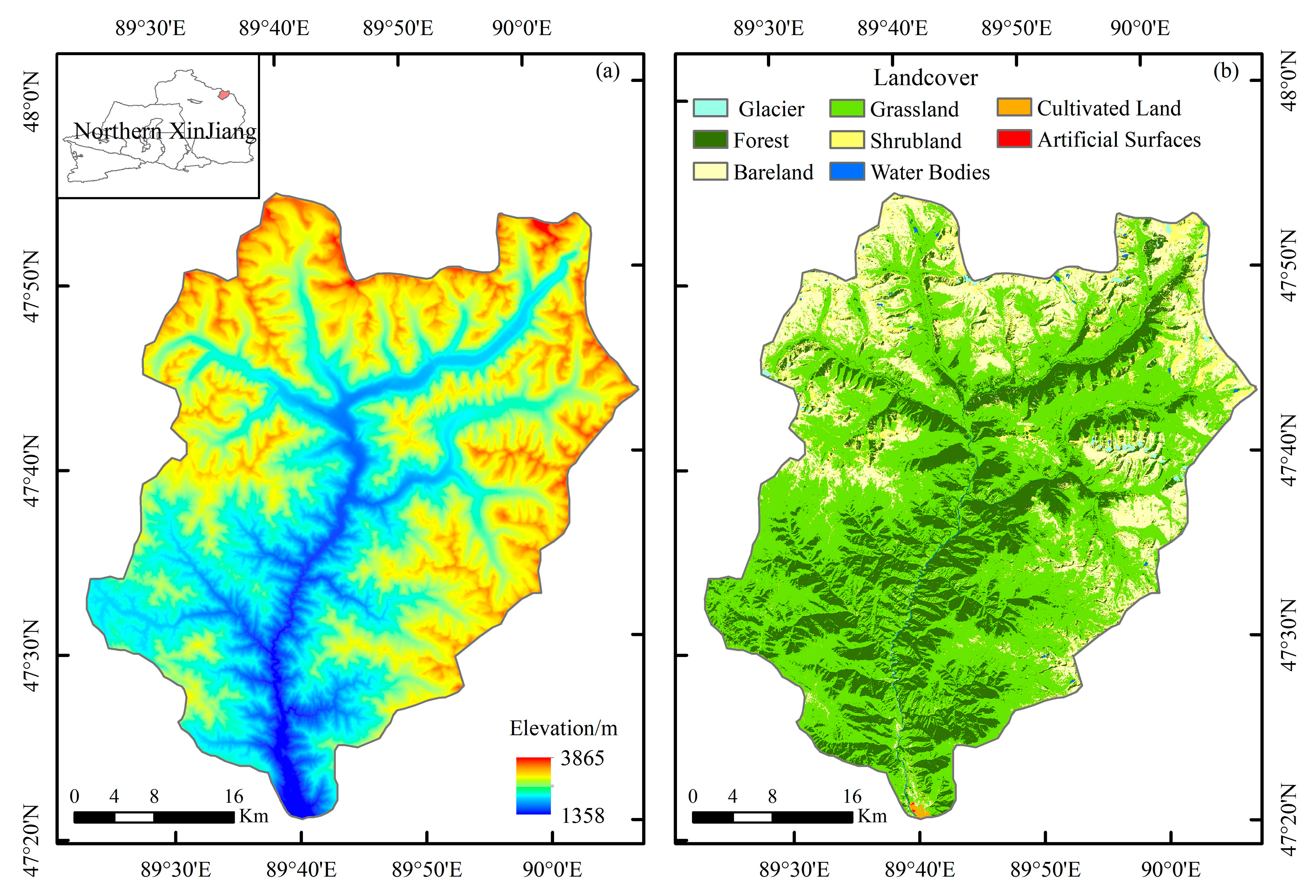

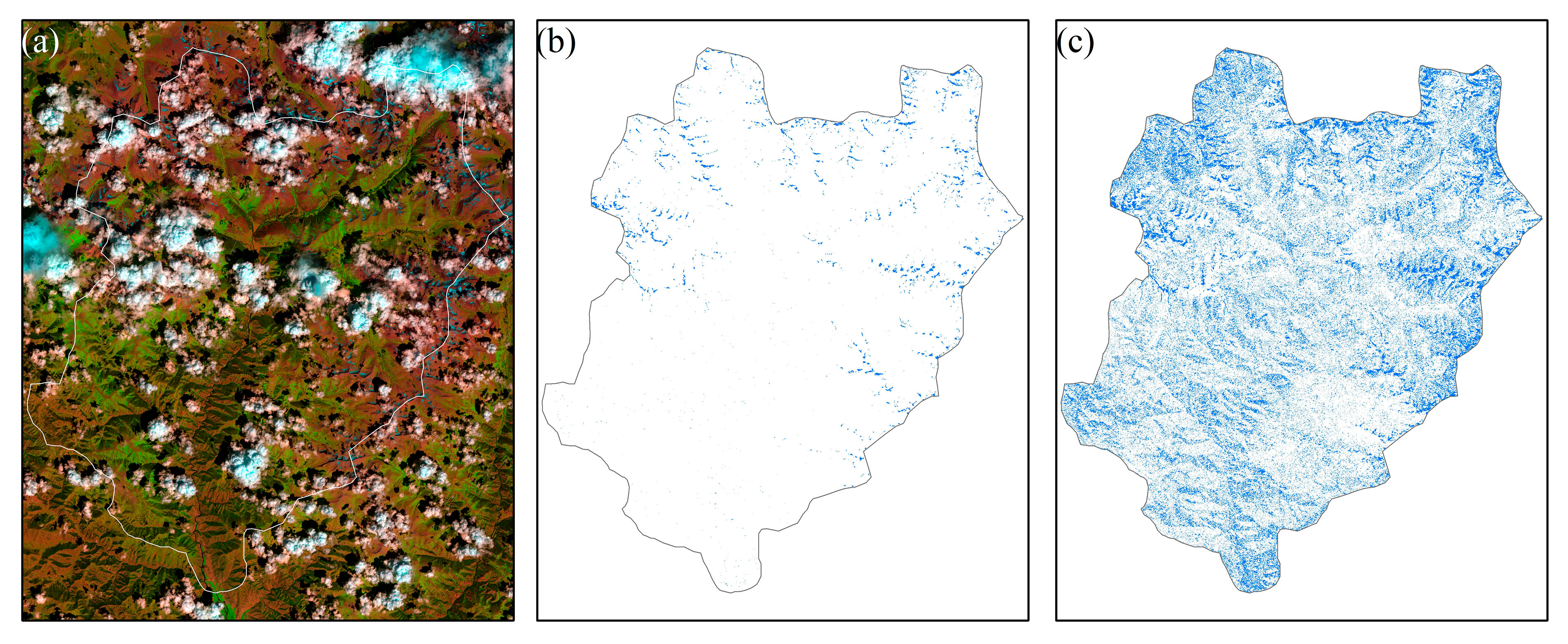
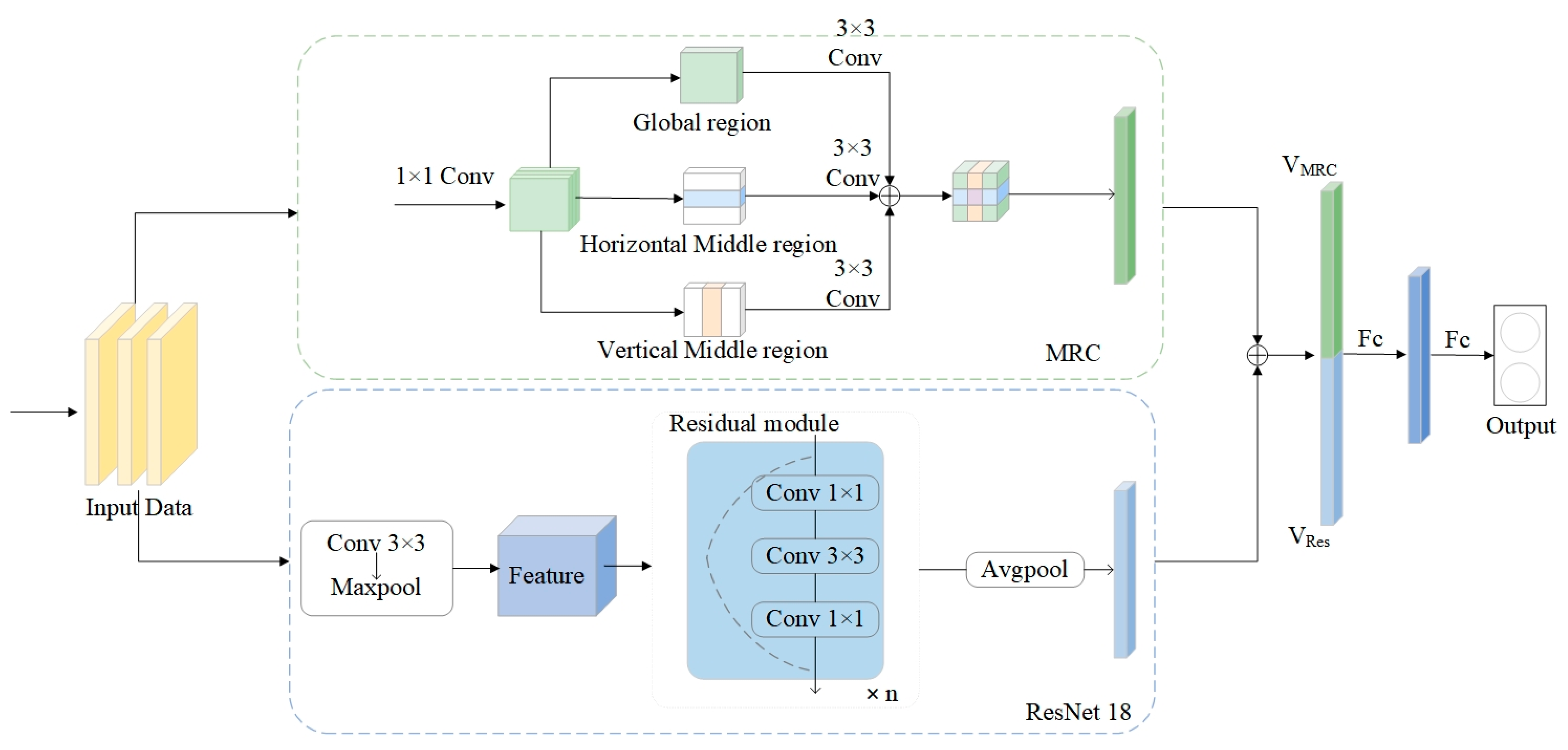


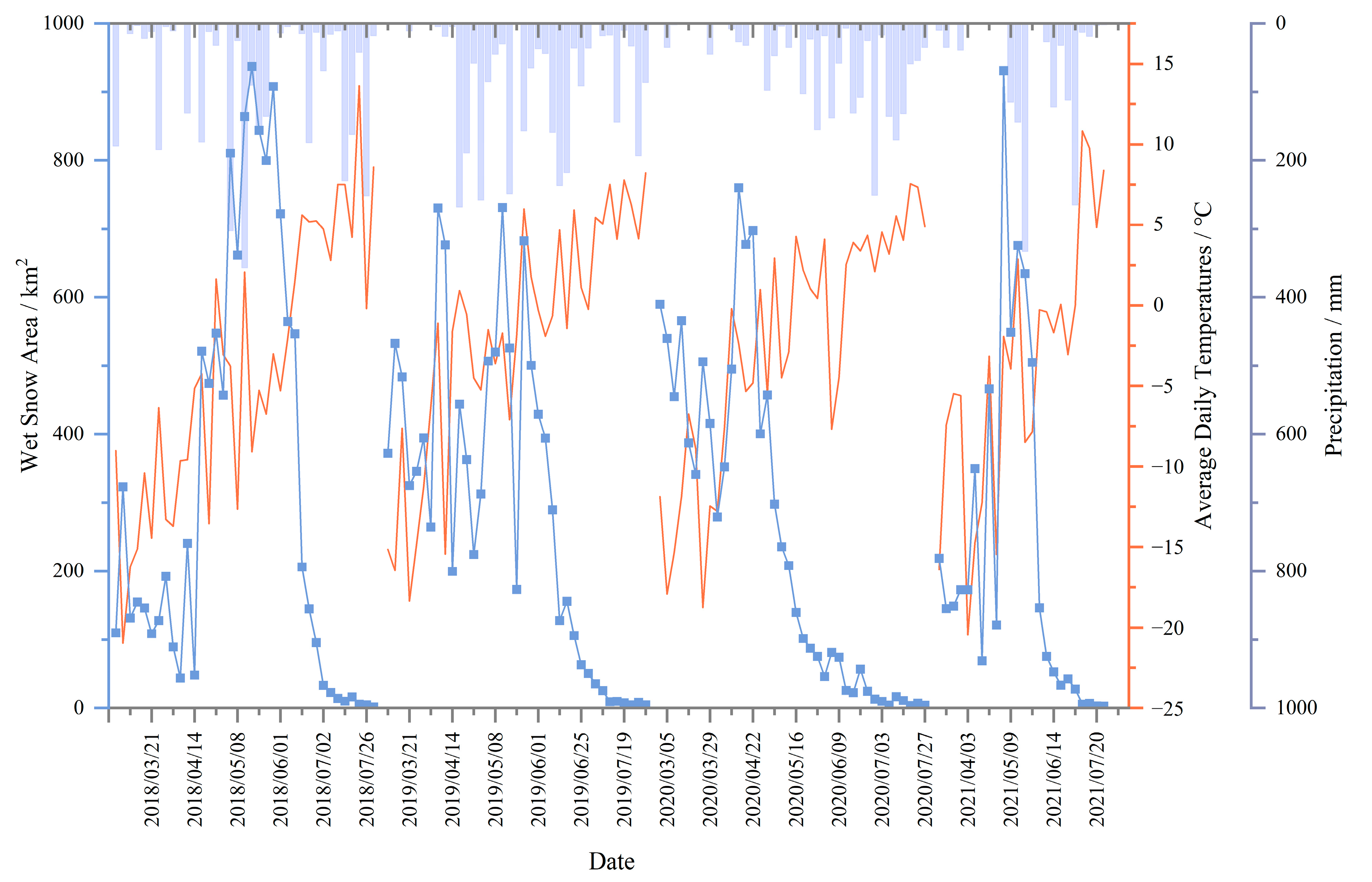


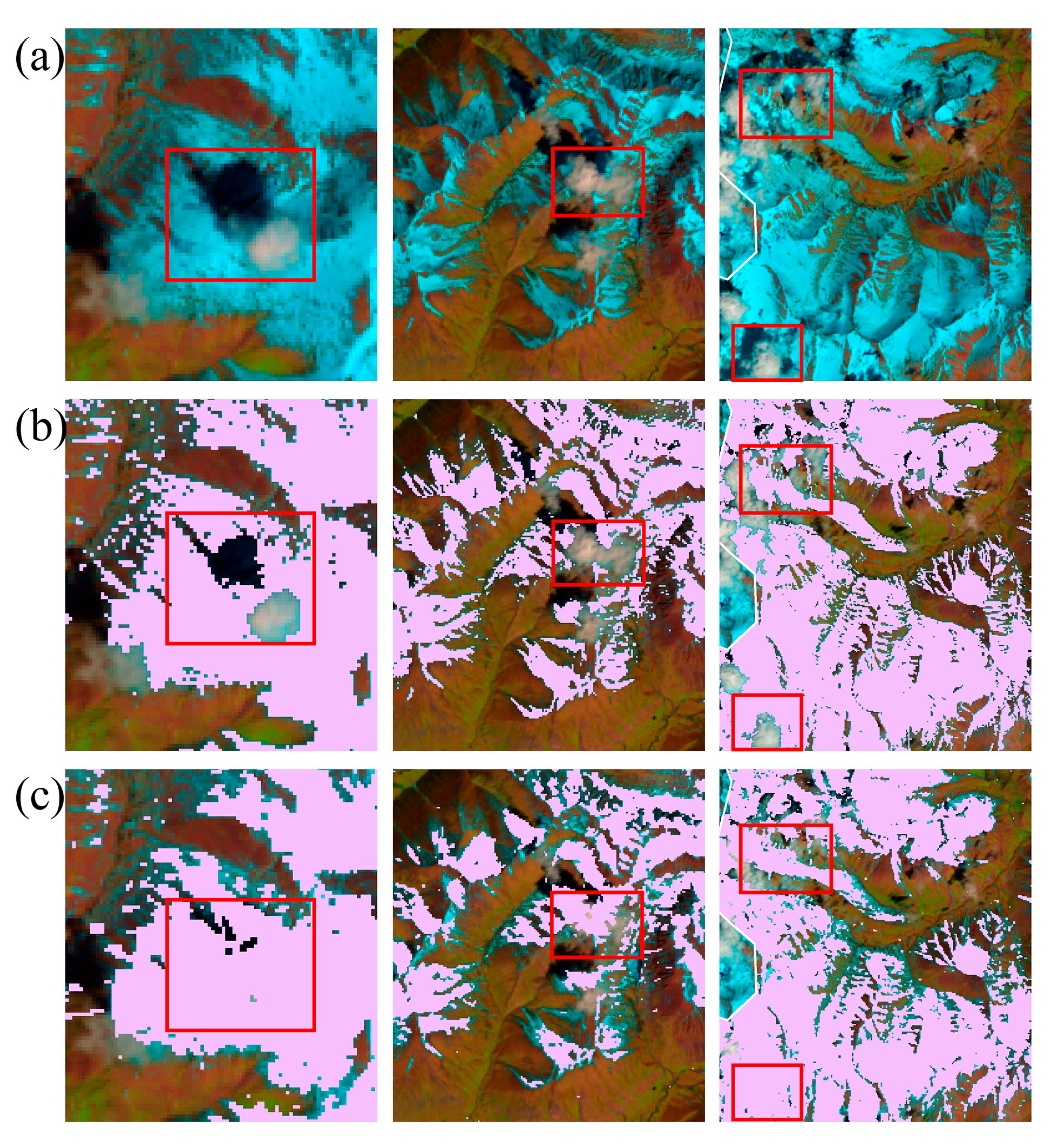
| Data Type | Data Parameters | Acquisition Date | ||
|---|---|---|---|---|
| Radar Remote Sensing Image | 15 May 2018 | |||
| Imaging Mode: IW | 2 July 2018 | |||
| Center Frequency: C-band | 3 June 2019 | |||
| Sentinel-1 GRD | Polarization Mode: VV + VH | 20 June 2019 | ||
| Spatial Resolution: 5 × 20 m | 22 April 2020 | |||
| Revisit Cycle: 12 days | 9 May 2021 | |||
| 4 June 2021 | ||||
| Optical Remote Sensing Image | 15 May 2018 | |||
| Bands | Green Band Near Infrared Band Shortwave Infrared Band | 2 July 2018 | ||
| 3 June 2019 | ||||
| Landsat 8 OLI | 19 June 2019 | |||
| Spatial Resolution: 30 m | 18 April 2020 | |||
| Revisit Cycle: 18 days | 7 May 2021 | |||
| 8 June 2021 | ||||
| Auxiliary Data | SRTM DEM | Spatial Resolution: 30 m | - | |
| Land-Cover Data | Spatial Resolution: 30 m | - | ||
| Neighborhood Size (r) | 5 | 7 | 9 | 11 | 13 | 15 |
| F1-score/% | 78.3 | 79.6 | 78.6 | 78.4 | 78.1 | 77.4 |
| Sentinel-1 Date | Landsat Date | Method | Overall Accuracy/% | Precision/% | Recall/% | F1/% |
|---|---|---|---|---|---|---|
| 15 May 2018 | 15 May 2018 | Threshold Method | 78.1 | 99.3 | 67.8 | 80.6 |
| OTSU | 71.4 | 99.8 | 57.4 | 72.9 | ||
| FCM | 72.0 | 99.8 | 58.4 | 73.7 | ||
| Our Method | 72.8 | 99.8 | 59.6 | 74.6 | ||
| 2 July 2018 | 2 July 2018 | Threshold Method | 98.6 | 36.1 | 44.6 | 39.9 |
| OTSU | 61.3 | 2.4 | 92.2 | 4.6 | ||
| FCM | 98.7 | 38.9 | 39.4 | 39.1 | ||
| Our Method | 97.3 | 22.6 | 65.9 | 33.6 | ||
| 3 June 2019 | 3 June 2019 | Threshold Method | 87.7 | 92.6 | 61.3 | 73.8 |
| OTSU | 87.1 | 93.2 | 58.8 | 72.1 | ||
| FCM | 87.7 | 92.6 | 61.3 | 73.8 | ||
| Our Method | 89.7 | 90.0 | 71.7 | 79.8 | ||
| 20 June 2019 | 19 June 2019 | Threshold Method | 95.8 | 36.9 | 58.4 | 45.2 |
| OTSU | 93.2 | 27.2 | 76.7 | 40.1 | ||
| FCM | 96.1 | 38.7 | 53.1 | 44.8 | ||
| Our Method | 96.2 | 39.6 | 53.2 | 45.4 | ||
| 22 April 2020 | 18 April 2020 | Threshold Method | 69.5 | 96.9 | 52.5 | 68.1 |
| OTSU | 66.8 | 97.4 | 47.7 | 64.1 | ||
| FCM | 68.7 | 97.1 | 60.0 | 66.9 | ||
| Our Method | 71.5 | 96.9 | 55.7 | 70.7 | ||
| 9 May 2021 | 7 May 2021 | Threshold Method | 64.9 | 98.3 | 42.4 | 59.3 |
| OTSU | 66.4 | 98.1 | 45.2 | 61.9 | ||
| FCM | 69.0 | 97.6 | 49.7 | 65.9 | ||
| Our Method | 71.9 | 97.2 | 55.0 | 70.3 | ||
| 4 June 2021 | 8 June 2021 | Threshold Method | 96.9 | 72.2 | 51.9 | 60.4 |
| OTSU | 79.3 | 16.3 | 87.2 | 27.5 | ||
| FCM | 96.0 | 54.5 | 65.6 | 59.6 | ||
| Our Method | 96.7 | 63.9 | 63.6 | 63.8 |
| Method | Overall Accuracy/% | Precision/% | Recall/% | F1/% |
|---|---|---|---|---|
| Threshold Method | 84.5 | 76.0 | 54.1 | 61.0 |
| OTSU | 75.1 | 62.1 | 66.5 | 49.0 |
| FCM | 84.0 | 74.2 | 55.4 | 60.5 |
| Our Method | 85.2 | 72.9 | 60.7 | 62.4 |
| Identifier | Channel Combinations |
|---|---|
| a | RC, RVV, RVH |
| b | RC, VVmelt, elevation |
| c | RC, VVmelt, slope |
| d | RC, VHmelt, elevation |
| e | RC, VHmelt, slope |
| f | RC, elevation, slope |
| g | VVmelt, VVsnow-free, elevation |
| h | VVmelt, VVsnow-free, slope |
| i | VVmelt, elevation, slope |
| j | VVmelt, VHsnow-free, elevation |
| k | VHmelt, VHsnow-free, slope |
| l | VHmelt, elevation, slope |
| m | VVmelt, VHmelt, elevation |
| n | VVmelt, VHmelt, slope |
| a | b | c | d | e | f | g | h | i | j | k | l | m | n | |
|---|---|---|---|---|---|---|---|---|---|---|---|---|---|---|
| OA/% | 84.2 | 83.6 | 85.2 | 84.8 | 84.8 | 84.4 | 78.3 | 84.5 | 80.6 | 81.4 | 83.6 | 80.6 | 82.3 | 79.7 |
| F1/% | 60.6 | 59.7 | 62.4 | 61.7 | 62.2 | 61.3 | 47.5 | 60.3 | 53.4 | 56.1 | 59.2 | 52.3 | 55.1 | 49.5 |
Disclaimer/Publisher’s Note: The statements, opinions and data contained in all publications are solely those of the individual author(s) and contributor(s) and not of MDPI and/or the editor(s). MDPI and/or the editor(s) disclaim responsibility for any injury to people or property resulting from any ideas, methods, instructions or products referred to in the content. |
© 2024 by the authors. Licensee MDPI, Basel, Switzerland. This article is an open access article distributed under the terms and conditions of the Creative Commons Attribution (CC BY) license (https://creativecommons.org/licenses/by/4.0/).
Share and Cite
Gong, H.; Yu, Z.; Zhang, S.; Zhou, G. Detection of Wet Snow by Weakly Supervised Deep Learning Change Detection Algorithm with Sentinel-1 Data. Remote Sens. 2024, 16, 3575. https://doi.org/10.3390/rs16193575
Gong H, Yu Z, Zhang S, Zhou G. Detection of Wet Snow by Weakly Supervised Deep Learning Change Detection Algorithm with Sentinel-1 Data. Remote Sensing. 2024; 16(19):3575. https://doi.org/10.3390/rs16193575
Chicago/Turabian StyleGong, Hanying, Zehao Yu, Shiqiang Zhang, and Gang Zhou. 2024. "Detection of Wet Snow by Weakly Supervised Deep Learning Change Detection Algorithm with Sentinel-1 Data" Remote Sensing 16, no. 19: 3575. https://doi.org/10.3390/rs16193575
APA StyleGong, H., Yu, Z., Zhang, S., & Zhou, G. (2024). Detection of Wet Snow by Weakly Supervised Deep Learning Change Detection Algorithm with Sentinel-1 Data. Remote Sensing, 16(19), 3575. https://doi.org/10.3390/rs16193575







